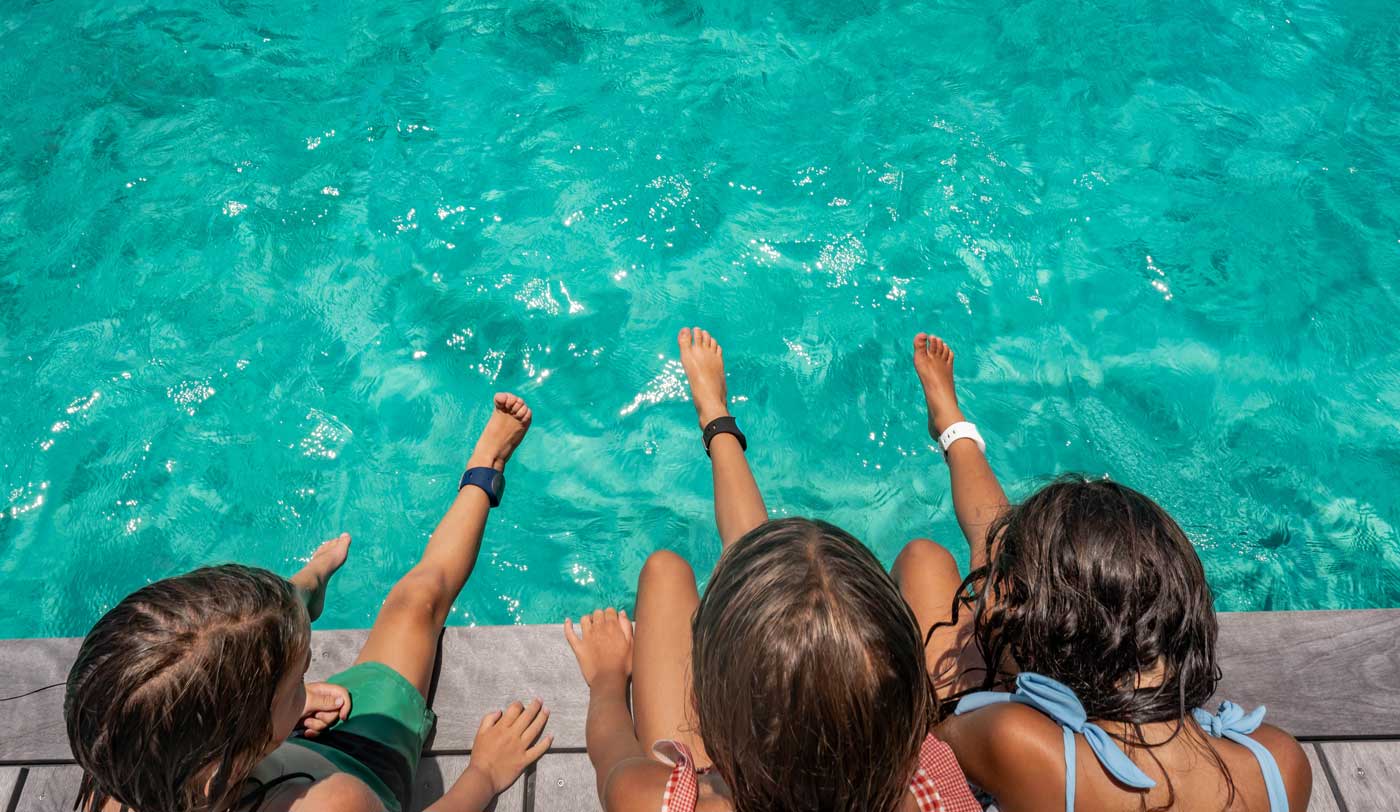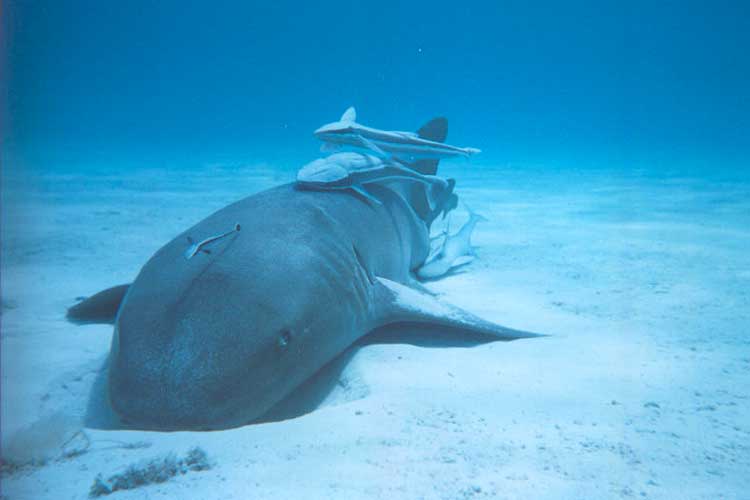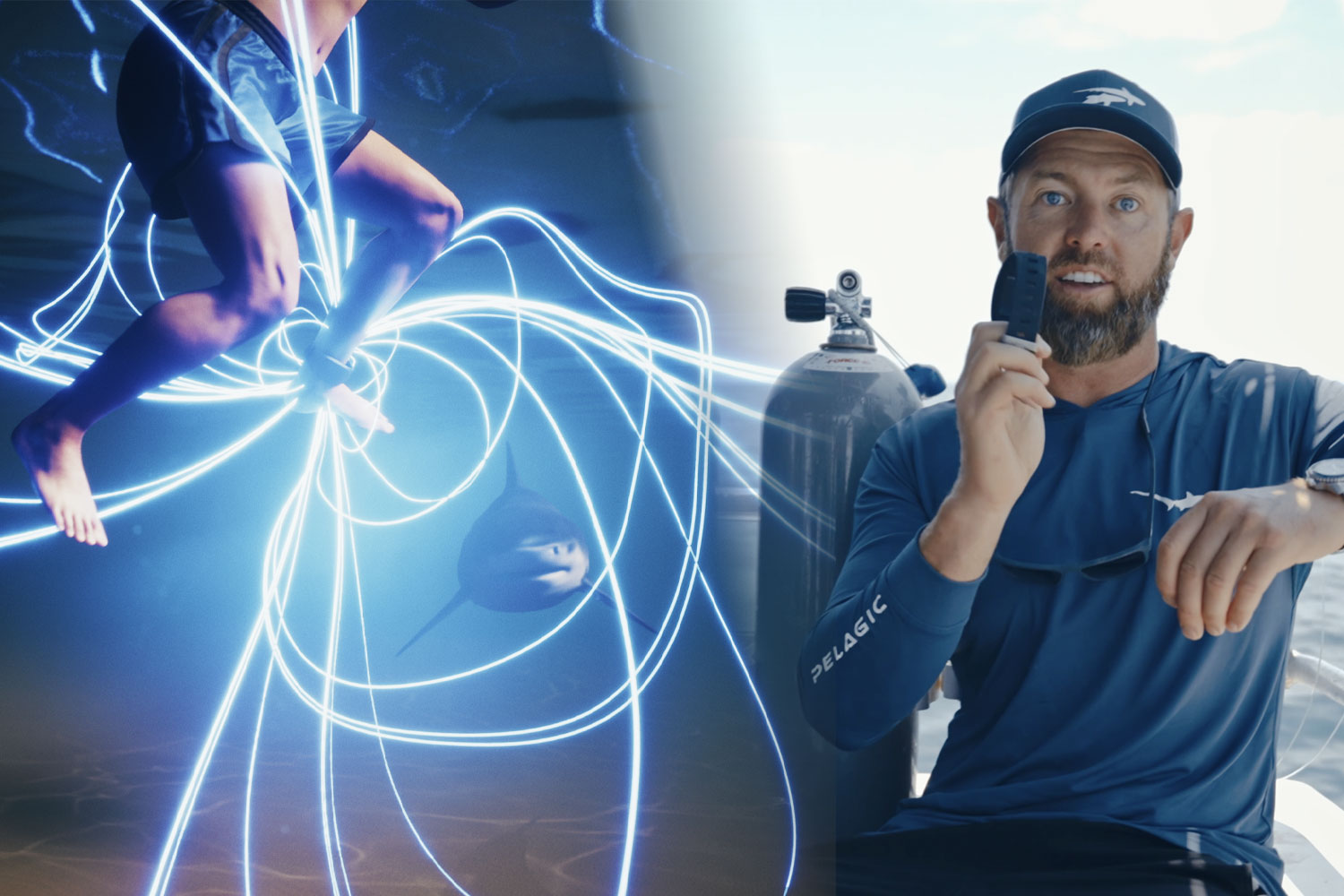For centuries, humans have pondered and marveled at the wondrous ways of sharks. These ancient predators are some of the most efficient creatures in the ocean.
Despite the pervasiveness of sharks in our culture, we still do not understand a lot when it comes to these impressive organisms, and there is room for debate about whether sharks sleep. In this article, we assess scientific studies on shark sleep and analyze topics such as:
- Do Sharks Sleep at All? While there is still a lot we do not know about the nature of shark sleep, recent studies on some species of sharks indicate that they enter a state of reduced activity and unresponsiveness associated with sleep.
- Do Sharks Sleep While Swimming? Different sharks rely on different biological systems to ensure that their gills receive the constant water flow necessary for them to breathe, and this, along with a host of other factors, determines how sharks engage in sleep.
- Do Great White Sharks Sleep? Some shark species, including Great White sharks, remain in motion, making sleep seem unlikely; however, in 2016, scientists revealed that even great white sharks have adaptive behavior allowing for periods of rest.
- How Long Do Sharks Sleep? How long sharks sleep varies depending on the species, with some species only receiving brief bursts of sleep as short as a few seconds, and other sharks entering a sleep-like state for much of the day or night.
- Do Sharks Stop Swimming? Unlike ram ventilators, such as Great White sharks, some sharks have a breathing process known as buccal pumping, which allows them to draw water over their gills by use of cheek and neck muscles without the need to continually swim. Other sharks have spiracles behind their eyes that act as snorkels to draw in water while stationary. As such, yes, some shark species stop swimming.
- Conclusion: Additional research is necessary for a full understanding of shark sleep, but there is convincing evidence that many shark species, if not all, have biological and behavioral adaptations that allow them to enter a sleep state.
I. Do Sharks Sleep at all?
The answer to the question, “Do sharks sleep at all?” hinges on the definition of sleep. According to the Cambridge Dictionary, sleep is defined as “the resting state in which the body is not active and the mind is unconscious.” From a medical perspective, sleep is linked to the physiological changes that occur during a resting state, including an organism’s metabolic rate and how its brain functions.
Sleep researchers have not studied all animals, but every animal they have studied has demonstrated behavior consistent with the scientific understanding of sleep. From jellyfish and mollusks to arthropods and roundworms, they all sleep.
But do sharks sleep? Put another way, do sharks enter a resting state during which their bodies are not active, their minds are not conscious, and other physiological changes occur that are consistent with a sleep state?
As the earliest jawed vertebrates, sharks may hold prehistoric evidence as to how sleep evolved in the animal kingdom, but studying sharks presents a host of challenges. Strictly speaking, scientists have yet to perform the full set of rigorous studies across a wide range of shark species that would be necessary to make a blanket conclusion on whether sharks sleep.
However, studies have been performed on a limited number of shark species, and many of them demonstrate that sharks do enter a state of reduced activity and unresponsiveness commonly associated with sleep.
For many years, scientists had only been able to study the behavioral aspects of shark sleep. One of the biggest discoveries concerning shark sleep behavior came in 2020 when a team of researchers published data showing that Port Jackson and draughtsboard sharks require more arousal during periods of inactivity. Their lack of responsiveness to potential danger suggests that their minds are not fully conscious during these periods and, therefore, the sharks are in a sleep state.
Nonetheless, scientists had yet to examine a shark’s physiological changes, such as oxygen intake and brain function.
Then, in March 2022, that same team of researchers took it a step further and provided physiological evidence of shark sleep. The researchers placed seven draughtsboard sharks in outdoor aquaria with natural light conditions and used infrared camera technology and custom-written software to monitor their behavior and metabolism over a 24-hour period.
Since sharks had shown reduced responsiveness after resting for five minutes or more in their previous study, the researchers sought to determine if this state was accompanied by a change in metabolism. Alas, they discovered that sharks in this sleep state decreased their oxygen intake, indicating a drop in metabolic rate consistent with the scientific definition of “sleep.”
The team hailed their findings as “the first physiological evidence of sleep in sharks.”
In the same study, researchers found that the sharks sometimes closed their eyes and sometimes kept them open during these sleep states. They also noted that the sharks flattened their posture to be level with the ground, as opposed to the more upward-facing posture they exhibit while awake.
Based on these findings, it is reasonable to conclude that draughtsboard sharks, if not all sharks, enter a resting state during which their bodies are not active, they require more arousal to be stirred (and therefore their minds are unconscious or semi-conscious), and they undergo physiological changes commonly associated with sleep, such as a drop in metabolism.
Therefore, the answer to the question, “Do sharks sleep at all?” is yes—scientific data demonstrates that at least draughtsboard sharks display sleep-like behavior consistent with conventional and scientific definitions of “sleep,” though more studies are required to determine if all sharks sleep.
How draughtsboard sharks sleep is particular to their species, which is capable of dispersing water over the gills without swimming. We discuss the other ways in which sharks sleep in the next section, “Do Sharks Sleep While Swimming?"
II. Do Sharks Sleep While Swimming?
It is a common misconception that all sharks must swim to stay alive. Some shark species, including tiger sharks, nurse sharks, and the draughtsboard sharks discussed above, can stop swimming entirely, and even partially bury themselves on the ocean floor, while maintaining the ability to breathe.

These types of sharks have cheek and neck muscles that pull in water through the mouth and out through the gills, a method of breathing known as buccal pumping. They also have spiracles—tiny openings behind the eyes—that draw in water if their mouths are closed or covered.
Other types of sharks rely on a method of breathing known as ram ventilation. This group of sharks, which includes great white sharks, whale sharks, and mako sharks, must swim with their mouths open to ensure that water flows over their gills. The slower they move, the less oxygen they receive. If they stop swimming, they can no longer breathe and die.
The reef shark is one of many shark species that breathe through both ram ventilation and buccal pumping. This allows them the flexibility to slow down and even stop completely without losing the ability to breathe.
Since many species of sharks have hybridized breathing systems and do not have to swim to stay alive, the question becomes whether sharks that rely solely on ram ventilation are still able to sleep.
While the studies on buccal-pumping sharks are more extensive and demonstrate more clearly that sharks enter a sleep or sleep-like state, the studies on ram-ventilating sharks are fewer and not as resounding. Nevertheless, scientists have been able to make a number of observations that would seem to suggest that ram-ventilating sharks also enter a sleep or sleep-like state.
Basking sharks, which are ram ventilators, have been seen lackadaisically basking in the sun near the ocean surface and they did not respond when touched. In another study, researchers noticed that blue sharks and bull sharks engaged in little to no activity for extended periods of time, and they were unresponsive unless the researchers handled them roughly.
Other ram-ventilating sharks, like gray nurse sharks, have been known to swim around the same area with frequent changes of direction, an activity known as milling. While milling, the sharks exert less energy, but they are more responsive to stimuli than other sharks studied.
Based on these studies and others, many scientists believe that ram-ventilating sharks do enter a sleep or sleep-like state, but more evidence is required to determine the exact nature of this shark behavior. The rapid progression of camera technology has made capturing video evidence easier than ever, and we will look at some groundbreaking video evidence to help answer the next question, “Do Great White Sharks Sleep?”
III. Do Great White Sharks Sleep?
As ram-ventilating apex predators, great white sharks are particularly difficult to study, but researchers have unearthed evidence that great white sharks do enter a sleep or sleep-like state.
Only a few studies exist on the subject of whether great white sharks sleep. In a study from 1982, researchers tracked a juvenile Great White shark and did not notice a change in activity level throughout the 24-hour day. However, subsequent studies in 2007 and 2013 found that great white sharks increased swimming activity during the night.
Then, in 2016, a team of researchers tracked a female great white shark off the coast of Isla de Guadalupe, a small volcanic island in the Pacific Ocean about 150 miles west of Mexico’s Baja California Peninsula. The great white shark, known as Emma, changed behavior at night by seeking shallow water and remaining near the bottom of the ocean floor. While swimming lightly into a 3-kilometer-per-hour current, Emma opened her jaws to allow water to flow over her gills, and she appeared to enter a catatonic state.
As with other species of sharks, more studies are required to provide a comprehensive analysis of whether great white sharks sleep, but many believe the video evidence, which can be seen below, is the first time anyone has witnessed a Great White shark sleeping:
IV. How Long Do Sharks Sleep?
The amount of time that sharks spend in a state of rest varies depending on the shark species and the individual shark, as well as external factors, like predation risk and food availability. In the 2022 study on draughtsboard sharks, scientists determined that sharks restful for more than five minutes were likely to be asleep because their metabolic rates were lower during these periods. The sharks engaged in periods of both rest and sleep several times throughout the 24-hour day.
In another study, scientists observed that Port Jackson sharks drastically changed their behavior during the night, reducing their activity levels and possibly entering a sleep state. Other sharks, such as school sharks and smooth-hound sharks, maintain similar activity levels during night and day, but scientists believe these species may have an adaptation similar to birds that allows them to sleep for very short periods, sometimes seconds.
Other sharks engage in milling, during which they make frequent directional shifts but otherwise exert little energy. Scientists found that Nurse Sharks engage in milling for up to 85% of the day, though it is important to note that the sharks exhibited rapid avoidance behavior when approached by divers. This suggests that nurse sharks are conscious while milling, and therefore not fully asleep.
A more comprehensive analysis of sleep in a wide range of shark species is necessary to fully answer the question of how long sharks sleep, but there is compelling evidence that sharks sleep for a range of time scales. Some sharks may only sleep for a few seconds at a time, while others may rest through much of the day or night, depending on the shark species and whether the shark is a ram ventilator, buccal pumper, or both. The length of time that sharks spend in a state of rest or sleep is also affected by environmental factors such as water temperature, food availability, and predation risk.
V. Do Sharks Stop Swimming?
To be clear, some shark species do stop swimming. These sharks are capable of buccal pumping, a breathing method by which the shark’s cheek and neck muscles pull in water through the mouth and out over the gills. Buccal pumping sharks include Nurse sharks, Draughtsboard sharks, and Bull shark.
Other sharks depend on ram ventilation, a process that requires movement in order for the water to flow over their gills. These sharks, including great white sharks, blue sharks, and whale sharks, must continually swim or the oxygen does not flow over their gills and they die.
Another group of sharks have special adaptations known as spiracles, which allow them to breathe while beneath the sand on the ocean floor. Spiracles are snorkel-like openings behind the eyes that protrude through the sand and draw in water for the organisms to breathe. This allows sharks, such as horn sharks, to remain motionless beneath the sand as a means to hunt and avoid being hunted.
Not all sharks are limited to one breathing method. Sand tiger sharks, for instance, are capable of both ram ventilation and buccal pumping, so they can stop and continue swimming as suits them.
In conclusion, some sharks do stop swimming by using spiracles and/or buccal pumping to ensure that water continues to flow over their gills and give them the oxygen they need to live. Other sharks, however, rely on ram ventilation and do not stop swimming or they die.
VI. Conclusion
While the idea of sharks sleeping may seem strange, it is important to note that these creatures are not mindless jagged-tooth stalkers. Like all animals studied by sleep researchers, data shows that sharks enter a sleep or sleep-like state, likely as a means to conserve energy between feeding periods. Impressively, some shark species have adaptations that allow them to rest while maintaining constant motion, while others are capable of remaining motionless and even burying themselves beneath the sand while they sleep.
There is still much to learn about shark sleep behavior, but multiple studies indicate that, although it may not be a direct equivalent to how humans sleep, sharks do, indeed, sleep.
Sharkbanz Wearable Deterrents: A Reliable Option
For those entering waters where sharks are known to be, do not count on them to be asleep! In addition to observing the best safety practices, as described in our Shark Safety Guide, ocean-goers can rely on Sharkbanz wearable deterrents for an extra layer of protection. These convenient, wearable devices emit an electromagnetic field that is designed to repel sharks and prevent them from aggressively approaching and/or accidentally biting humans. Sharkbanz has been rigorously tested and proven effective, with numerous scientific studies, customer reviews, and news articles attesting to its effectiveness.









